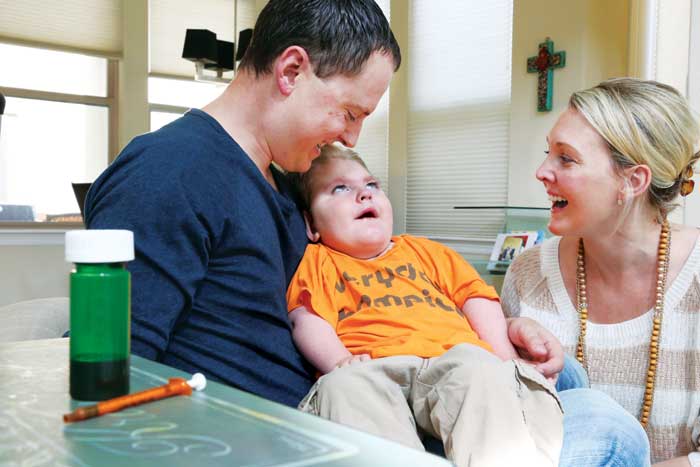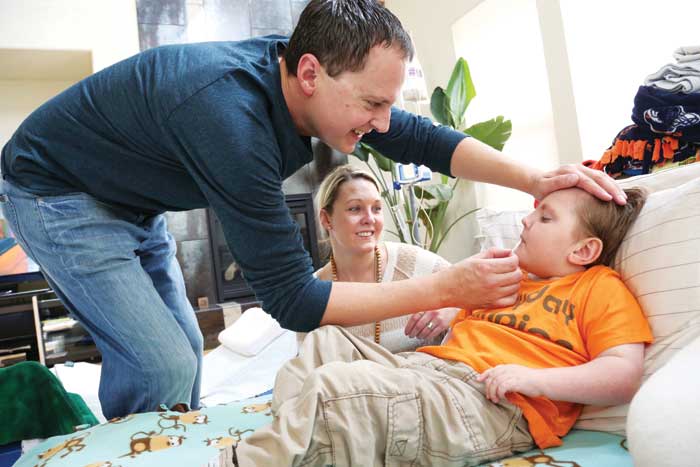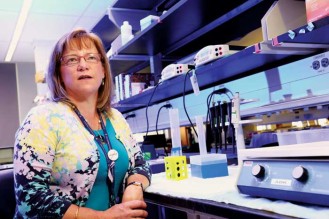
Zac and Summer Larsen laugh with their six-year-old son, Kingsley, in their Stapleton home. For one year, they have been using cannabis oil high in CBD (at front) to treat Kingsley’s seizures. Using a syringe they put one drop underneath his tongue. CBD oils, like Charlotte’s Web, have gained national attention for miraculous results treating epilepsy, but the Larsens have yet to see a significant effect on Kingsley’s seizures.
It was October 31, 2013. The group gathered in the living room of the Stapleton home. A nurse, part-time medical assistant and family members were all present, plus a neurologist and pediatrician on call.
Five-year-old Kingsley lay on the couch, hooked to a pulse-oxygen machine. This is his usual spot—a well-lit room in the heart of the house that streams sunlight from big windows. Using a syringe they put one drop of cannabis oil, a sticky-tar-looking liquid, under Kingsley’s tongue. Then the group waited anxiously, not sure for what.
Cannabis oil is extracted from a marijuana plant. Certain strains with low levels of the psychoactive chemical THC and high levels of cannabidiol (CBD) have shown evidence of controlling seizures. CBD oil goes by many names including Charlotte’s Web, the brand that’s grown national attention. Kingsley was one of the first children in Stapleton to try the oil for seizure control.
Within the first 24 hours, Kingsley started to do things he had never done before. He moved and stretched his arms. He tried pushing against the couch to sit up on his own, and his eyes tracked movement in the room. And for the first time in his life he spoke. “Mom,” he said.
“I almost fell over. I literally thought I was going to die,” says Kingsley’s mom, Summer Larsen. “It was the most amazing 24 hours.”
Although the CBD oils help Kingsley cognitively be more alert, they have done little to improve his seizures. At Children’s Hospital Colorado, less than a quarter of parents see any significant change in their child’s epilepsy from CBD oils.
Kingsley is undiagnosed, and doctors say he is medically fragile with special needs. He is nonverbal, nonmobile and eats through a G-tube. He has recurrent seizures, which classifies as epilepsy.
According to the Epilepsy Foundation, epilepsy is characterized by disturbed brain activity that causes unpredictable seizures. If normal brain activity is an orchestra performance, a seizure is the time before the performance when all the musicians are chaotically testing their instruments at the same time. Seizures can vary from an eye flicker to full-body convulsions.
Epilepsy is the fourth leading neurological disorder, affecting 2.5 million people in the U.S., including more than 400,000 kids. There are no cures, but more than 30 medications, dietary therapies, surgical options, and devices prevent or stop seizures. Still, one-third of people with epilepsy do not find relief in any of the current treatments; hence, many turn to alternatives.
In the last year, there has been a surge of desperate families moving to Colorado seeking CBD oils for their epileptic kids, many of whom come to Children’s Hospital Colorado asking about medicinal marijuana.
“Being at the end of your rope, why wouldn’t you try something that could possibly help your child?” Summer says. She wears a baseball hat, sweatshirt and yoga pants—her go-to most days. She comments about having dark circles under her eyes, but there’s no sight of them. She has a round face similar to Drew Barrymore with light ash blonde hair the color of ginger ale. She laughs and smiles a lot during the interview.
She takes advantage of this time out of the house and nibbles on a muffin in between talking—sometimes she’s so busy at home she forgets to eat. Summer is Kingsley’s Certified Nurse Assistant (CNA), or a health care provider who cares for a person living with a severe disability under the supervision of a registered nurse. A CNA is trained, certified and paid for their care. A parent of a disabled child may choose to be a CNA to guarantee reliable health care and income.
Six years ago, Summer never would have expected her life to go the directions it has. She used to be a “fashion girl, snotty, self-absorbed and only cared about all the materialistic stuff in life.” For 10 years she owned a clothing store in Larimer Square. She met her husband, Zac, who owned a record store, and they married. Then Summer got pregnant.

As Summer watches, Zac uses a cotton swab to apply lip balm on Kingsley as part of their daily caretaking routine. Kingsley is non-verbal, non-mobile and eats through a G-tube.
In utero they knew Kingsley was going to have issues, but didn’t know to what extent. When he was born doctors couldn’t determine a diagnosis, but said Kingsley would be severely disabled for the rest of his life and may not live to be 1. Nine hours after being born he had his first seizure.
At 6 months, Kingsley started having infantile spasms, a seizure that causes stiffening of the arms and legs. At 1, he entered the Butterfly Program at Children’s Colorado, which helps children and their families who have been diagnosed with a terminal illness and are at the end of their lives.
The family tried anything that might help, including medications from the black market in France, diet changes, therapies, and treatments. All the while, they continuously did genetic tests, hoping to reach a diagnosis but receiving negative results.
For a time, they seemed to find the right combination of medication and therapies to cut down the number of seizures, but as Kingsley grew they lost seizure control. “Seizures are a big mystery,” Summer says. “As he gets older, the seizures take on a different part of the brain.”
Two years ago, Kingsley’s seizures were almost constant, and at one point he was up to 100 a day. When they were out of options they decided to try CBD oil. “It’s mostly … marijuana,” she says, quieting her voice. When they first started trying the oils she was nervous to talk about it, but has started to feel more comfortable.
The Larsens order two brands of CBD oil every month: Charlotte’s Web and Haley’s Hope.
Charlotte’s Web in Colorado Springs is the most well-known strain of CBD oil. A couple of brothers in Colorado Springs accidentally grew a marijuana plant with very high CBD and very low THC. They originally named it “Hippie’s Disappointment” because it lacks the high feeling. A woman asked them to make it into an oil for her daughter, Charlotte, who has severe epilepsy. The oil significantly reduced her seizures and brought national attention to Charlotte’s Web.
Haley’s Hope in Longmont also offers CBD oils. Unlike Charlotte’s Web, it is not a dispensary, but an individual caregiver who currently serves 90 families.
There are many complications to using CBD oil. Every month the CBD oil is a different strength. In the very first dose, the ratio of CBD to THC was 55/1, a very strong strain. They’ve never seen that ratio again, sometimes even dipping into strains higher in THC.
At their house, Summer opens the fridge, where a magnet holds a picture of Kingsley as an infant—so tiny he’s wearing a Build-A-Bear Broncos outfit—and holds the bottles of CBD oils from the two companies side by side. The difference is striking—one is golden colored and the other dark with plant matter. She’s frustrated with the inconsistency and never knowing what they will get each month.
In addition to the oils, Kingsley takes two anti-epileptic drugs and does therapy five days a week.
They continue to go to Children’s Hospital Colorado, where doctors do not prescribe, recommend or manage using medicinal marijuana, but will monitor potential side effects.
“One of the concerns in the epilepsy community about medical marijuana, including Charlotte’s Web, for the treatment of seizures is there are individual cases that seem to have had miraculous response, but there are really no well-controlled studies,” says Dr. Amy Brooks-Kayal, pediatric epileptologist and chair of neurology at Children’s Colorado, one of the four comprehensive epilepsy centers in the U.S.
There is little to no knowledge of the potential long-term effects of marijuana on a developing brain, including memory and learning abilities. Doctors also don’t understand how marijuana interacts with other medications. Some children have gone into toxic shock from combining CBD oils with epilepsy medications.

Dr. Amy Brooks-Kayal is a huge proponent of epilepsy research. She sits in the Lab of the Translational Epilepsy Research Program at the University of Colorado Anschutz Campus.
Brooks-Kayal is concerned that the doctors prescribing red cards to families have no epileptic or neurologic expertise.
Clinical research does not already exist because the federal government has continually denied funding. Currently, two pharmaceutical companies are beginning the first clinical studies on marijuana, which Brooks-Kayal says we may see results from in a few years.
To make up for the lack of federal funding, Gov. Hickenlooper recently signed a bill stating the Colorado Health Department will give out $9 million in grants in the next five years to researchers for marijuana studies. Dr. Christian Thurstone from the University of Colorado hopes to apply for a grant to study CBD.
Brooks-Kayal hopes research can identify which kids CBD works uniquely for and why. “If it’s really effective I want all my patients to have access, but only if it’s effective.”
Luckily, being one of the first families to use the oils, the Larsens don’t have to wait to receive them every month—Charlotte’s Web has a backlog of 1,200 people. Because Kingsley uses such a small dose, they pay $100 a month for the CBD oils while some families can spend more than $1,000 a month. If clinical studies find the oils are effective and it’s produced through a pharmaceutical company, it can become FDA-approved and potentially covered through insurance.
Until then, families pay out of pocket.
“I don’t know how much it’s really working for us, but I don’t want to stop it,” Larsen says. Her current hope for the future is a more consistent oil.
On September 17, Kingsley celebrated his sixth birthday. He enrolled in first grade at Isabella Bird Community School that allows him and Summer to Skype into special education classes, which also helps Summer and Zac feel more a part of the community.
Unlike many marriages Summer has seen fail among the community of terminally ill families at Children’s Colorado, she and Zac are doing really well. They joke about having leg wars in bed to get up and care for Kingsley in the night. “It’s really hard. You fight and there are hard days, but I couldn’t have married a better person to be going through this with me.”
Because of their experience with CBD oils, they are opening a dispensary in Log Lane Village near Fort Morgan where there is little access to medicinal marijuana.



This was a very helpful read, I am trying to find ways to get the best medicine into the hands of the patients that need it the most. It seems that forming a Dr.s group( a group of Dr.s) working to establish a patient database explaining doses used and comparing techniques used in growing that can sharpen the THC and CBD profiles would be a good start.
While it is clear from research the benefits of cbd’s there is a wide gap in research for THC and it’s effectiveness in seizures. The OG kush plant has been touted as the most tumor inhibitive strain,and has been used with amazing results from direct pump application to inoperable areas of the brain.Trying new strains that are heavy with THC and low in CBDs could prove effective for a lot of families that are not able to get quality CBD oils .
I wrote the most objective story possible with the information and research I collected. I chose not to focus on the Stanley Brothers because of the amount of publicity they’ve already received. As a community paper, we put a local focus on our articles, in this case one family’s experience working with doctors at Children’s Hospital Colorado. The reference to 25 percent of parents who have seen a significant effect in their children’s epilepsy from CBD oils was referring specifically to patients at Children’s Colorado, which was stated. Because this was not a story about the Stanley Brothers’ research, we encourage interested readers to get more information and welcome any sources you’d like to share.
Some of the information in this article is inaccurate, especially regarding tbe 5 Stanley brothers who created Charlotte’s Web. It was no accident that they grew the plant, although they originally had not intended to create it for use in pediatric medicine, they intended to use in adult epilepsy patients. Their first patient, Charlotte’s mom, sought them out and pled with them to help her and they didn’t have the heart to turn her away. The 5 men/brothers are highly skilled and educated in various specialties including biomolecular science. They work and live in Boulder, not the Springs. They have been working on and researching their products for many years and have a cutting edge research lab in which they design and test their products. I think perhaps providing more information about their credible background would make for a more accurate piece that doesn’t diminish their qualifications and subsequently the products or successes they provide to patients. Some of the statistical information referenced about success with only a quarter of patients is also inaccurate.The slant of the article comes off as though they are some basement potheads “accidentally” creating medicine to treat really sick children. Hope this helps others who may not know this to do more thorough research for themselves.
Madeline Schroeder’s article on the Stapleton family utilizing cannabis oil to ease their child’s epileptic seizures was touching, well written and informative. In summary, it was great journalism as journalism was meant to be. Congratulations!